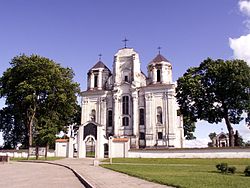Kraziai
| Kražiai | ||
|---|---|---|
| Town | ||
 |
||
|
||
| Location of Kražiai | ||
| Coordinates: 55°36′N 22°41′E / 55.600°N 22.683°ECoordinates: 55°36′N 22°41′E / 55.600°N 22.683°E | ||
| Country |
|
|
| Ethnographic region | Samogitia | |
| County | Šiauliai County | |
| Municipality | Kelmė district municipality | |
| Eldership | Kražiai eldership | |
| Capital of | Kražiai eldership | |
| First mentioned | 1257 | |
| Population (2011) | ||
| • Total | 603 | |
| Time zone | EET (UTC+2) | |
| • Summer (DST) | EEST (UTC+3) | |
Kražiai (Samogitian: Kražē) is a historic town in Lithuania, located in the Kelmė district municipality, between Varniai (32 km) and Raseiniai (44 km), on the Kražantė River. The old town of Kražiai is an archeological and urban monument.
The population in 1959 was 998; ca. 2,000 in 1939; 1,761 in 1897. The town has a secondary school and is a rural community centre. Under the prewar Republic of Lithuania, Kražiai was the township seat of the county of Raseiniai. After World War II it was assigned to the Soviet administrative district of Kelmė.
Kražiai is one of the older settlements in Samogitia. Many barrow graves and fortress hills are located in its vicinity. The name of the locality is first mentioned (as Crase) in a 1257 document of King Mindaugas, by which a part of Samogitia was assigned to the Teutonic Order. Vytautas the Great during his first years of rule ceded Samogitia to the Order; the regent he appointed lived in Kražiai. After the Battle of Grunwald in 1410, when Samogitia regained its freedom, Kražiai became the district centre. In the 15th century Kražiai was the christening centre of Samogitia. In the 17th century it became one of the Catholic centres of the country. There were several monasteries, and the Jesuits established Kražiai College.
With the transfer of the gymnasium to Kovno in 1848, and owing to a devastating fire the following year, the town lost its importance. After the construction of the Libau–Romny Railway in 1880 it became still poorer, and many families emigrated to the United States, Africa, and Australia.
...
Wikipedia


